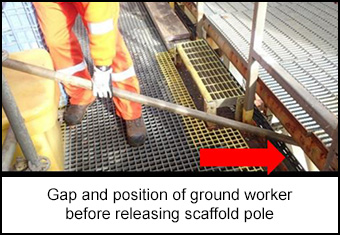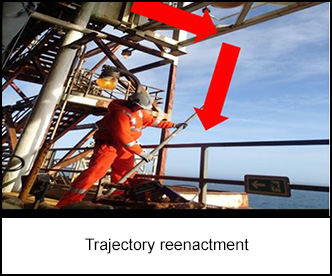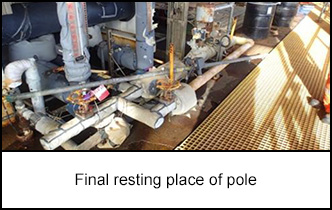-
What happened?
Three workers were erecting scaffolding on a top deck. One scaffolder was called away to work on another task.
The worker on the scaffold platform passed down a 10 foot (3 metres), 12 kg (27 lbs) pole to the ground worker who was holding a separate 10 foot pole (3 metres).
The ground worker leaned the existing scaffold pole on a salt storage box to free his hand and grab the next pole.
When he released the pole, it slipped through the 4 inch (10 cm) gap between the kick plate and the bottom of the east pipe rack. It then fell 30 feet (9 metres), hitting the pipe rack structure and handrail, and bounced inboard across the walkway, landing on pipework.
There was no injury to personnel or equipment, with the nearest person to this incident being 20 feet (6 metres) away.

-
Why did it happen?
The groundworkers failed to notice that the pole was protruding through the opening prior to releasing grip.
No barriers had been installed below, as the risk of the pole falling through the opening had not been identified.
Crew member was called away from site to perform other duties and no ‘step back 5 X 5’ was conducted following the change in crew.

-
What did they learn?
Improve job safety analyses (JSA’s), highlighting the limitations of composite crews and mentorship verification; step back when the crew composition changes.
Develop new drops checklist for use with all permits: how can tools/equipment become drop hazards?
Consider salience bias (the tendency to focus on more visible and obvious risks or information, and miss less noticeable things).

-
Ask yourself or your crew
How can something like this happen here?
If the crew composition changes, what should we do?
During risk assessment, how can we draw attention to less noticeable risks?
What risks may we have missed on today’s job?
What additional dropped object barriers can we introduce on today’s job? (If any).

Add to homescreen
Content name
Select existing category:
Content name
New collection
Edit collection
What happened?
Three workers were erecting scaffolding on a top deck. One scaffolder was called away to work on another task.
The worker on the scaffold platform passed down a 10 foot (3 metres), 12 kg (27 lbs) pole to the ground worker who was holding a separate 10 foot pole (3 metres).
The ground worker leaned the existing scaffold pole on a salt storage box to free his hand and grab the next pole.
When he released the pole, it slipped through the 4 inch (10 cm) gap between the kick plate and the bottom of the east pipe rack. It then fell 30 feet (9 metres), hitting the pipe rack structure and handrail, and bounced inboard across the walkway, landing on pipework.
There was no injury to personnel or equipment, with the nearest person to this incident being 20 feet (6 metres) away.

Why did it happen?
The groundworkers failed to notice that the pole was protruding through the opening prior to releasing grip.
No barriers had been installed below, as the risk of the pole falling through the opening had not been identified.
Crew member was called away from site to perform other duties and no ‘step back 5 X 5’ was conducted following the change in crew.

What did they learn?
Improve job safety analyses (JSA’s), highlighting the limitations of composite crews and mentorship verification; step back when the crew composition changes.
Develop new drops checklist for use with all permits: how can tools/equipment become drop hazards?
Consider salience bias (the tendency to focus on more visible and obvious risks or information, and miss less noticeable things).

Ask yourself or your crew
How can something like this happen here?
If the crew composition changes, what should we do?
During risk assessment, how can we draw attention to less noticeable risks?
What risks may we have missed on today’s job?
What additional dropped object barriers can we introduce on today’s job? (If any).
Workers were erecting scaffolding on a top deck. One scaffolder was called away to work on another task. The worker on the scaffold platform passed down a 10 foot (3 metres) pole to the ground worker. When the ground worker released the pole, it slipped through the gap between the kick plate and the bottom of the east pipe rack. It then fell 30 feet (9 metres), hitting the pipe rack structure and handrail.











